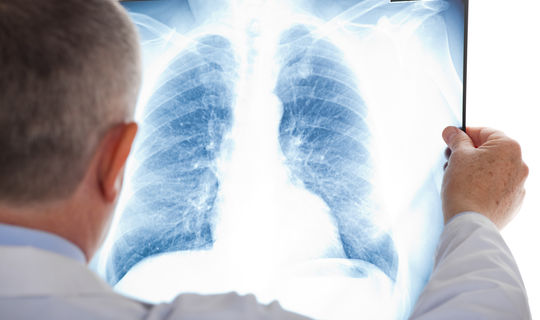Pulmonary Fibrosis

Published: 18 Jun 2025
ICD9: 516.31 ICD10: J84.112 ICD11: CB03.4
Pulmonary fibrosis is a chronic and progressive lung disease characterized by the scarring (fibrosis) and thickening of the lung tissue.
This scarring makes it difficult for oxygen to pass from the lungs into the bloodstream, leading to shortness of breath and other symptoms.
Here's a breakdown:
![]() Pulmonary: Refers to the lungs.
Pulmonary: Refers to the lungs.
![]() Fibrosis: Refers to the formation of scar tissue.
Fibrosis: Refers to the formation of scar tissue.
Key features of Pulmonary Fibrosis:
![]() Scarring: The normal, healthy lung tissue is replaced by scar tissue. This scar tissue is stiff and less flexible, making it harder for the lungs to expand and contract properly.
Scarring: The normal, healthy lung tissue is replaced by scar tissue. This scar tissue is stiff and less flexible, making it harder for the lungs to expand and contract properly.
![]() Progressive: The scarring typically worsens over time. This means that the disease gets progressively more severe, leading to increasing shortness of breath and other complications.
Progressive: The scarring typically worsens over time. This means that the disease gets progressively more severe, leading to increasing shortness of breath and other complications.
![]() Irreversible: Once the scar tissue forms, it's generally not possible to reverse it. Current treatments focus on slowing down the progression of the disease and managing symptoms.
Irreversible: Once the scar tissue forms, it's generally not possible to reverse it. Current treatments focus on slowing down the progression of the disease and managing symptoms.
What happens in the lungs?
Imagine your lungs are like a sponge. In a healthy lung, the sponge is soft and flexible, allowing it to absorb and release air easily. In pulmonary fibrosis, the sponge becomes stiff and hardened due to the scar tissue. This makes it difficult to breathe and transfer oxygen to the bloodstream.
Causes:
In many cases, the cause of pulmonary fibrosis is unknown, and it's then called idiopathic pulmonary fibrosis (IPF). Other known causes can include:
![]() Environmental factors: Exposure to pollutants, asbestos, silica dust, and certain molds.
Environmental factors: Exposure to pollutants, asbestos, silica dust, and certain molds.
![]() Medications: Certain medications, such as chemotherapy drugs, heart medications, and antibiotics.
Medications: Certain medications, such as chemotherapy drugs, heart medications, and antibiotics.
![]() Medical conditions: Some autoimmune diseases (like rheumatoid arthritis, lupus, and scleroderma), viral infections, and chronic aspiration.
Medical conditions: Some autoimmune diseases (like rheumatoid arthritis, lupus, and scleroderma), viral infections, and chronic aspiration.
![]() Genetics: In some cases, pulmonary fibrosis can run in families.
Genetics: In some cases, pulmonary fibrosis can run in families.
Symptoms:
![]() Shortness of breath, especially with exertion
Shortness of breath, especially with exertion
![]() Dry, hacking cough
Dry, hacking cough
![]() Fatigue
Fatigue
![]() Unexplained weight loss
Unexplained weight loss
![]() Clubbing of the fingers and toes (widening and rounding of the fingertips and toes)
Clubbing of the fingers and toes (widening and rounding of the fingertips and toes)
![]() Aches in muscles and joints
Aches in muscles and joints
Diagnosis:
Diagnosing pulmonary fibrosis typically involves:
![]() Medical history and physical exam
Medical history and physical exam
![]() Imaging tests: Chest X-ray, CT scan (high-resolution CT scan is especially helpful)
Imaging tests: Chest X-ray, CT scan (high-resolution CT scan is especially helpful)
![]() Pulmonary function tests: These tests measure how well your lungs are working.
Pulmonary function tests: These tests measure how well your lungs are working.
![]() Lung biopsy: In some cases, a small sample of lung tissue is taken for examination under a microscope to confirm the diagnosis.
Lung biopsy: In some cases, a small sample of lung tissue is taken for examination under a microscope to confirm the diagnosis.
Treatment:
There is currently no cure for pulmonary fibrosis. However, treatments are available to help slow down the progression of the disease, manage symptoms, and improve quality of life. Treatments may include:
![]() Medications: Antifibrotic medications can help slow down the scarring process.
Medications: Antifibrotic medications can help slow down the scarring process.
![]() Oxygen therapy: To help improve oxygen levels in the blood.
Oxygen therapy: To help improve oxygen levels in the blood.
![]() Pulmonary rehabilitation: A program of exercises and education to help improve breathing and overall function.
Pulmonary rehabilitation: A program of exercises and education to help improve breathing and overall function.
![]() Lung transplant: In severe cases, a lung transplant may be an option.
Lung transplant: In severe cases, a lung transplant may be an option.
Important Note: Pulmonary fibrosis is a serious condition, and it's important to see a doctor if you're experiencing symptoms. Early diagnosis and treatment can help slow down the progression of the disease and improve your quality of life.